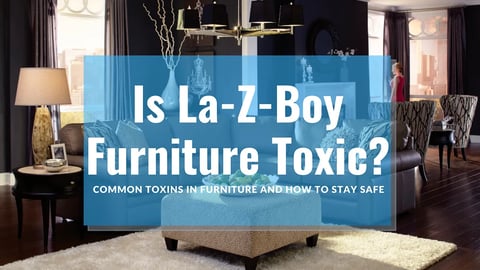Is La-Z-Boy Furniture Toxic: Common Toxins in Furniture & How to Stay Safe
July 8, 2025

Est. Reading Time: 11 mins
When investing in furniture for your home, safety is always a top concern. La-Z-Boy is known for its high-quality, sustainable, and non-toxic living room furniture products, but a common question remains: Does our furniture contain toxic materials?
In this article, we will explore the materials used in La-Z-Boy furniture, common toxins found in furniture, and La-Z-Boy’s commitment to non-toxic, sustainable furniture.
Key Takeaways:
- La-Z-Boy uses certified materials to ensure safety and sustainability.
- Common furniture toxins include VOCs, formaldehyde, and flame retardants.
- La-Z-Boy minimizes chemical exposure through certifications and eco-friendly practices.
- Learn how to mitigate the health risks of common furniture toxins in your home.
In this Article…
- Is La-Z-Boy Furniture Toxic?
- Materials Used in La-Z-Boy Living Room Furniture
- Safety Certifications for Non-Toxic Living Room Furniture
- Common Toxins Found in Furniture
- Tips to Improve Air Quality with Safe Furniture Choices
Is La-Z-Boy Furniture Toxic?
Magaly del Castillo, the interior designer at La-Z-Boy Cyrville, reminds us that La-Z-Boy has been a trusted name in the furniture industry for over 90 years. "While the brand is well-known for its comfortable, long-lasting pieces, many consumers wonder whether La-Z-Boy furniture contains harmful chemicals."
Let’s break down what La-Z-Boy is doing to ensure that its products are as safe as possible for your home.
Materials Used in La-Z-Boy Living Room Furniture
La-Z-Boy takes pride in using high-quality materials in its furniture, ensuring both durability and safety.
Fabrics & Leathers
La-Z-Boy offers over 800 different fabrics and leathers, many of which are eco-friendly or antimicrobial. Specialty fabrics, such as those with iClean Technology, provide a stain-resistant barrier without harmful chemicals, making them ideal for families with children or pets.
La-Z-Boy carries an Antimicrobial Fabric that uses non-toxic silver to protect against bacteria. These fabrics also make furniture maintenance easier while keeping your home environment safe.
To learn more about our La-Z-Boy Fabrics, take a look at this guide.
Foam
The foam used in La-Z-Boy cushions is made from high-resilience polyurethane foam, designed to offer superior comfort and longevity. "Unlike competitor foams, La-Z-Boy’s foam maintains its shape over time and emits minimal levels of harmful chemicals," Magaly says. This makes it a safer choice for households concerned about toxic exposure, especially in frequently used living areas.
La-Z-Boy’s ComfortCore® cushions, available in stationary furniture, feature multiple layers of foam for targeted support and optional gel-infused upgrades for enhanced comfort and temperature regulation.
Wood Frames
La-Z-Boy’s furniture frames are constructed primarily from Oriented Strand Board (OSB), a material known for its strength and durability.
OSB is less likely to warp or separate compared to traditional plywood and meets strict safety standards for furniture with low formaldehyde emissions. Using OSB in furniture framing reflects La-Z-Boy’s commitment to sustainability, as it is more environmentally friendly than many other wood materials.
You can learn more about the Quality of Wood Used at La-Z-Boy by reading this article.
Safety Certifications for Non-Toxin Living Room Furniture
La-Z-Boy ensures the safety and quality of its furniture through various certifications.
UFAC Certification
The Upholstered Furniture Action Council (UFAC) certifies La-Z-Boy products to meet strict fire safety standards. This certification reduces the risk of furniture-based fires by ensuring that the materials used in La-Z-Boy’s upholstered pieces are less likely to ignite. Fire safety is a critical concern, and UFAC certification provides added assurance for homeowners.
Proposition 65 Compliance
La-Z-Boy complies with California’s Proposition 65, which identifies chemicals that can cause cancer, birth defects, or reproductive harm.
By adhering to Proposition 65, La-Z-Boy ensures that its products are free from many of the harmful chemicals found in other furniture brands, providing a safer option for your home.
Proposition 65 has a long list of chemicals that are considered extremely harmful. If you like to know what is included within Proposition 65’s list, follow this link.
UL Green Guard Certification
La-Z-Boy also participates in the UL Green Guard certification program, which ensures that its furniture meets low chemical emission standards. Over 700 La-Z-Boy products have achieved the Green Guard Gold standard, which tests for over 360 chemicals.
This certification ensures that La-Z-Boy furniture contributes to healthier indoor air quality, making it especially valuable for households with children, pets, or individuals with respiratory sensitivities.
Common Toxins Found in Furniture
Furniture from various brands, including some budget alternatives, can contain harmful substances that affect indoor air quality and pose health risks. The following are some common toxins found in furniture:
- VOCs (Volatile Organic Compounds): Emitted by upholstery and finishes, VOCs can lead to health problems when inhaled over time. Luckily, many furniture stores, such as La-Z-Boy, carry VOC-free recliners and sofas.
- Formaldehyde: Found in glues and adhesives, this chemical is classified as a carcinogen, and long-term exposure can increase the risk of serious health issues.
- Benzene: Present in certain dyes and coatings, benzene exposure has been linked to blood disorders and other health complications.
- Flame Retardants: Chemicals like hexabromocyclododecane (HBCD) are used to prevent fires but can accumulate in the environment and impact reproductive and developmental health.
While these chemicals sound alarming, strict regulations exist in Canada and the U.S. to limit exposure levels in consumer products, ensuring that they meet safety standards. If you wish to learn about the various types of toxic chemicals that are used to make furniture, visit the Government of Canada’s webpage on Pollutants from Furniture and Building Materials.
Tips to Improve Air Quality with Safe Furniture Choices
Even though modern furniture is subject to regulations, Magaly advises taking additional steps to improve air quality in your home.
Air Purifiers
Using an air purifier is an effective way to reduce the presence of airborne toxins in your home. Air purifiers can capture VOCs and other harmful particles, making the air cleaner and safer to breathe, especially in smaller spaces like apartments or rooms with limited ventilation.
Proper Ventilation
Ensure proper ventilation in your home by regularly opening windows and using exhaust fans. Fresh air circulation helps flush out any accumulated chemicals, improving indoor air quality. If you live in an area with larger windows or have access to outdoor spaces, regularly opening your windows will refresh the air inside and reduce toxin levels.
House Plants
House plants can naturally help reduce airborne toxins. Certain species, such as spider plants and peace lilies, are particularly effective at removing VOCs and other harmful substances from the air. Placing plants throughout your home can improve air quality while adding a touch of greenery to your space.
Open Your Windows Often
Similar to an air purifier, letting in new air by opening up your windows every now and then does wonders! If you are living in hotter climate temperatures and have bigger windows, this technique is an ideal one for you. Keeping your window open is not only good for eliminating toxins, but it is also overall healthier for yourself and others since you're letting clean air in and letting bad air out.
Regular Cleaning
Regular cleaning, such as dusting and vacuuming, can help remove particles that carry toxins. Dust tends to accumulate on furniture surfaces, carrying residual chemicals from upholstery or finishes.
By keeping your living space clean, you not only improve indoor air quality but also minimize the buildup of harmful particles.
What's Next?
Now that you’ve learned about what goes into making La-Z-Boy furniture, you can ensure that you are making healthy home furnishing practices in Ontario. That being said, why not get yourself a piece of furniture today?
You can take a look at our furniture online, or you can visit our Ottawa, Gatineau & Kingston locations. You can also schedule an appointment online to talk to one of our design consultants about any questions or concerns you may have about our furniture.
To learn more about La-Z-Boy furniture in general, take a look at our Living Room Buyer’s Guide.
Related Articles
(1).jpg?width=150&height=150&name=9C8A3062-Enhanced-NR%20(1)(1).jpg)
Nicholas Carchidi
Content Writer at StyleMeetsComfort.ca
Nick has been the lead content writer for La-Z-Boy Ottawa, Gatineau and Kingston since 2022, specializing in the furniture industry. He collaborates with experts in his field, ensuring that each piece on the La-Z-Boy Learning Centre is accurate and valuable. He provides readers with expert knowledge on all things furniture. If you'd like to learn more about Nick, you can check out his LinkedIn page here.
Product Info Request
Please provide us with your name and email and we'll get back to you as soon as possible regarding this item.

